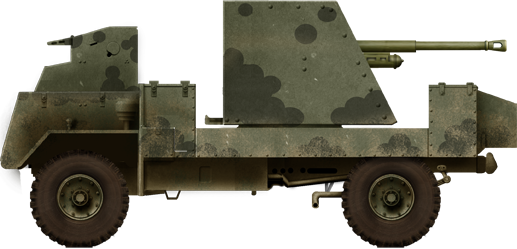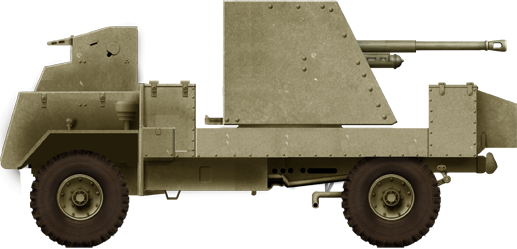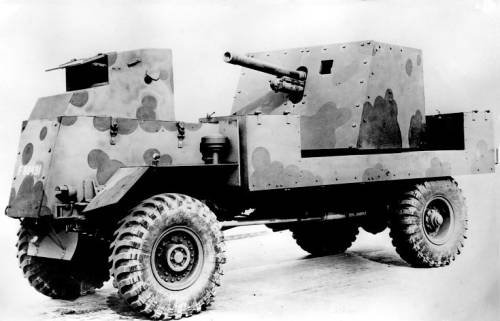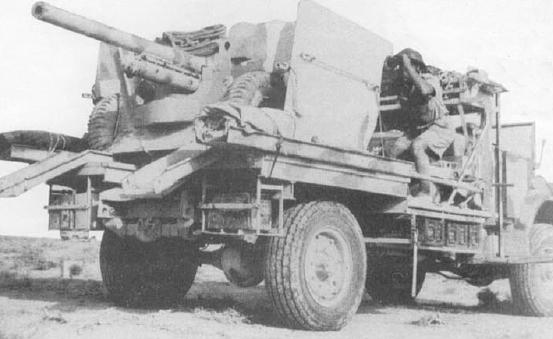Deacon Tank Destroyer
 (1941-42) United Kingdom - c170 built total
(1941-42) United Kingdom - c170 built total
A truck with a gun is no substitute
The “Deacon” also known by the Royal Ordnance AEC Mk I Gun Carrier or “Carrier, 6-Pdr Gun, A.E.C., Mk I Deacon” for the long form, was an improvised tank destroyer out of the mating of a QF 6 pounder and an AEC Matador truck chassis. The incentive was to provide British Army units operating in North Africa with a mobile anti-tank weapon in 1942. The generic concept was to use an artillery “en portee” system, with the gun place on the truck’s back, protected by a shield. The result was also completely armoured and therefore earned its place in this encyclopedia. “Deacon” was just another ecclesiastic denomination used for self propelled guns, on par with the Priest (M7), Bishop (British 25 pdr SPG) and Sexton (Canadian 25pdr SPG). The few converted served in the NA campaign until 1943 when most were converted back as supply vehicles or given up.
Design
To be effective as a not-too-heavy platform despite the added weight for the armour, the Matador chassis was spoiled of everything unnecessary. The cab for example was reduced to the bare minimum, next to the engine hood. The latter was a AEC A173 6-cyl diesel providing 95 hp (71 kW), and 7.8 hp/tonne for 12 tonnes, with an average speed of 19 mph (30 km/h) and range about 280 km at cruise speed. Being a 4×4 vehicle was not a problem compared to tracked ones in the desert. Armour was substantial, protecting against small arms fire overall but up to 20 mm on the nose.
The large open cargo bay was framed by corner storage bins for ammo, plus additional bins on the back. On the center of it layed the ROQF 6-pdr gun, standard antitank gun of the British Army, protected by a large custom shield that offered much better overall protection for the gunner and loader than the regular gun while the vertical sliding block breech still had plenty of room to recoil. In addition the mounting was modified out of an AA model which allowed for some extra elevation to be used in support rôle. This arrangement and reduced front superstructure allowed the gun a 300°+ degree unobstructed traverse.
About the gun
The 6 QF was a 2.24 in/57 mm caliber firing 57×441 mm rounds at 1,650 yd (1,510 m) optimal direct line of sight range to a maximum range at 5,000 yd or 4,600 m with parabolic trajectories. The weight of the barrel and breech was 2,520 lb (1,140 kg). Depending on the model the barrel length ranged from 43 to 50 calibers and muzzle velocity 846-855 m/sec with AP and APC ammo available in 1942. By 1943 the APCBC was introduced (800 m/sec) and in 1944 the APDS (1150 m/sec). It seems that when the Deacon was introduced only L43 caliber barrels 6-Pdrs were given, but these were still capable of penetrating 94 mm of armour at 100 m and therefore were more than capable of dealing with all German tanks deployed in North Africa at that stage in the war. Apart from this gun, there was no secondary armament but personal weaponry carried by the crew.
Operational history
The Deacon were produced in a short timespan from December 1942 to january 1943 and only 175 were ever manufactured/Converted. They played a significant rôle at the action at El Hamma with 76th Anti-Tank Regiment, securing a clear-cut victory over a mixed German Force including Panzer IIIs. Some survived to the Tunisian campaign but their rôle was considered over as new US-built tank destroyers and more capable British tanks were now provided, plus they were not suitable for the muddy battlefield and cluttered skies of Northern Europe. Many were converted back as supply carries or given to Turkey before the end of 1943.
Links
AEC Mk I Gun Carrier specifications |
|
| Dimensions | 6.39 x2.36 x2.82 m (21 x 7.9x 9.3 ft) |
| Total weight, battle ready | 12.2 tons |
| Crew | 4 (driver, Cdr, gunner, loader) |
| Propulsion | AEC A173 6-cyl diesel 95 hp (71 kW) |
| Suspension | 4×4 independent coil springs |
| Speed (road) | 30 km/h (19 mph) |
| Range | 280 km (175 mi) |
| Armament | 6 Pdr QF, 24 rounds |
| Armor | 8 mm sides to 20 mm front (0.3-0.8 in) |
| Total production | 175 in Dec.1942 |

AEC Mk I Gun Carrier with an early green camouflaged livery, dec. 1942.

Standard AEC Mk I Gun Carrier Deacon in desert livery, 1943.
Gallery

First production vehicle, December 1942.

Rear of an improvized Deacon, with the original 6 Pdr protected by side walls.

WW2 Tanks




























WW2 tanks posters

All Tiger tanks liveries.

Panther liveries and variants

WW2 Armour - All tanks











Tanks aces and single tanks series

Find more there

Museums, Movies, Books & Games
The Tanks and Armor in pop culture
Tanks and armored vehicles in general are only really grasped when seen first person: The mass, the scale, it's all there. Explore also the way tanks were covered in the movie industry, in books and in video games.Movies:
Best tanks movie on warhistoryonline.com
On imdb.com
On bestsimilar.com/
miltours.com
liveabout.com/
watchmojo.com
Video Games:
pcgamesn.com
historyhit.com
levvvel.com
vg247.com/best-tank-games
mmobomb.com/
alienwarearena.com
